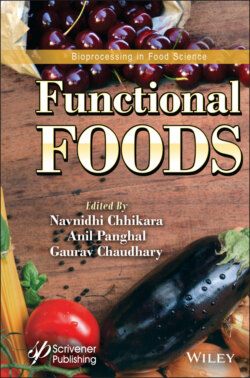Читать книгу Functional Foods - Группа авторов - Страница 21
1.4.3 Fruits and Vegetables Based Functional Foods
ОглавлениеFruits and vegetables contain abundant amount of various nutrients like vitamins, minerals, dietary fibers and health promoting phytoconstituents such as polyphenols, tannins, flavonoids, carotenoids [35]. Reservatol is important phytoconstituent in various fruits like berries, mulberry, pines, Indian blackberry, grapes and jackfruit etc. [36, 37]. This compound reported as anticancer, antioxidant, anti-inflammatory, antiallergic, platelet anti-aggregation, cardioprotective and modulator for lipid metabolism [38–40]. The postharvest treatment using ultra-violet radiation has been reported to develop grape berries with higher stilbenes [41] and functional table grapes [42] and grape juice with higher resveratrol concentration [43]. Various clinical, epidemiological and in-vitro studies suggested the health-beneficial characteristics of red wine in prevention of cardiovascular diseases and cancerous cells [44]. Resveratrol has been reported to act as antioxidant, antimutagen, anti-inflammatory, antipromotion activity, and anti-initiation, and antiprogression activity [45, 46].
Lycopene is a natural carotenoid pigment with antioxidant potential and provides red and pink color to fruits and vegetables like tomatoes, pink grapefruit, watermelons etc. The antioxidant potential has been demonstrated to possess protective effects against oxidative stress, atherosclerosis, hypertension, sunburn, infertility, liver damage, metabolic syndrome and diabetes [47, 48]. Lycopene has been extensively used as functional ingredient in different food formulations such as energy drinks, syrups, nectars, soft drinks, bakery, dairy, and meat products [49].
The consumer interest is more in dried fruits and vegetables as snacks to reduce the consumption of high energy desserts and consider these as a more healthy option [50]. The waste pomace from fruit and vegetable industry is also source of pectin, hemicelluloses, lignin and cellulose and can be used as functional ingredient in different food formulations [51, 52].
Herbs are small annual/perennial plants with aromatic quality and have juicy stems. These provide unique flavour and aroma to the food as well as possess health promoting benefits. Herbs are the valuable source of various types of the functional ingredients e.g. curcumin, menthol, gingerol, black pepper, capsaicin and coumarin in turmeric, peppermint, ginger, black pepper, chilli and coriander respectively [53]. Curcumin, characteristics component of turmeric, exhibited huge therapeutic potential and are effective in treatment of Parkinson’s disease, Alzheimer, sclerosis, cerebral injury, cardiovascular disease, cancer, diabetes, allergy, asthma, obesity, depression and bronchitis etc. [54, 55]. GRAS approval of curcumin has favoured its incorporation in wide range of foods like probiotics, beverages, soups, snacks, candy, baked products etc. and integral component of active packaging material [56–58].
